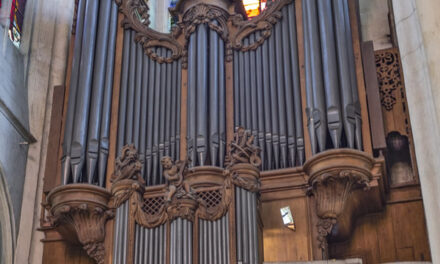Sometimes I like to go to Stewart Theater, in the Talley Student Center at NC State University, just for a big dose of red. There is an awful lot of blue in other parts of the Triangle. But the real reason to visit Stewart at least twice a year is Center Stage’s dance scheduling. There are always two dance programs each academic year, and often they include companies that have appeared at the American Dance Festival — or will in the future. You won’t see old-guard modern dancers here, but young companies and choreographers bursting with contemporary ideas and energy. On the 6th, a lot of that energy was expressed in red.
The ten-year-old Brian Brooks Moving Company, though founded in the closing years of the last century, has a very 21st century attitude, with an appreciation for low-production value media, mash-ups and mockery, along with a buoyant athleticism that often makes the rest enjoyable. Most interesting in the mix is Brooks’ synesthetic use of color. The vivid coloration of the lighting, floor coverings, costumes and props, keyed to the action and sound, make one suspect that Brooks has the neural makeup that associates certain colors with certain sounds, letters, numbers, shapes or movements.
The major work on this program was an edited version of Brooks’ 2005 piece Piñata, which was danced at the 2005 ADF. This shortened, tightened dance is much stronger than the original, while retaining all the delightful color effects. Repetition, much repetition, is Brooks’ artistic keystone, and in some sections you’d be happy for it to go on forever — but mostly it goes on a little too long. The small variations and intensifying tempo do not engage us quite thoroughly enough. In Piñata, the easy pleasure that accompanies the cheerful colors and marvelous costumes comes to an abrupt end when the work’s final section begins. The dancers have been moving, constantly moving, either through space or on the floor through several changes of music, but when Ravel’s Bolero begins, they appear dressed in black and take up stationary positions. Although this section was performed without the high camp attitude that had soured it at ADF — and appeared far more graceful than it had in that performance — still it is a mystery why it is a hand dance only. Most of the energy from the earlier sections is dissipated, and any possibility of a climax removed. It just ends, at last.
The program’s second work, Happy Lucky Sun (part 1, 2008), seemed more like a work-in-progress than a completed dance. Comprising sections stuck together seemingly at random, it was like the large paintings of high postmodernism: unrelated scenes and subjects lined up on the same canvas. Some of the dance sequences were identical to ones we’d seen before intermission; others seem to come in from another universe. Although again there was a delicious use of color, I could not discern another unifying factor, thread, motif, idea — the dance was just pieces. Luckily, it included a ravishing solo by Brooks — but, oddly, that did not go on long enough. The sun set before we got to any happy completion, which made me see a different kind of red.











